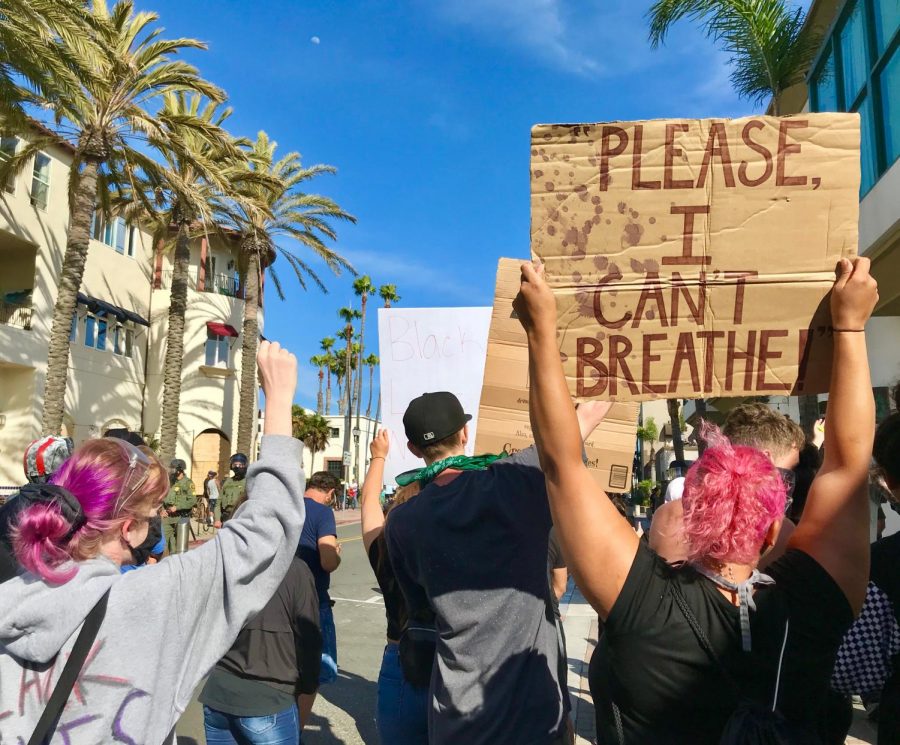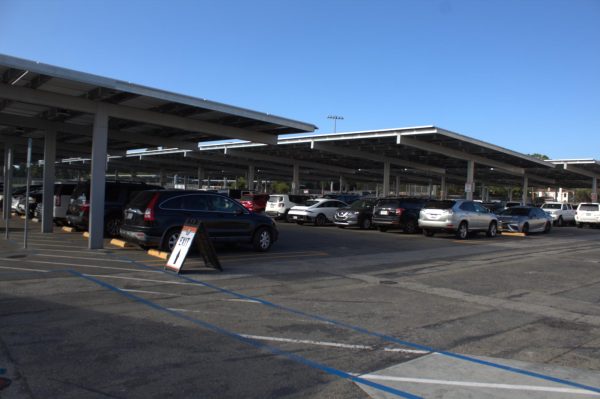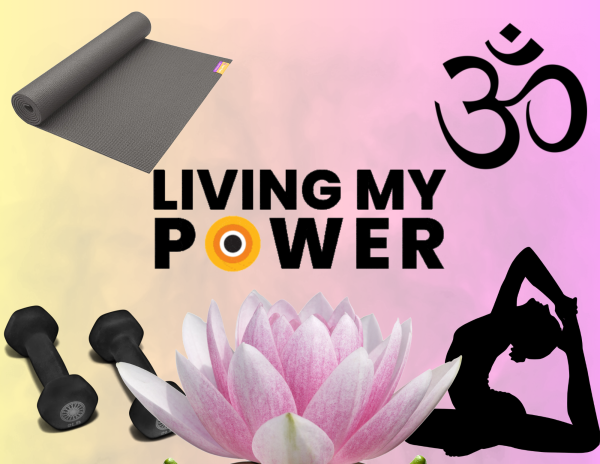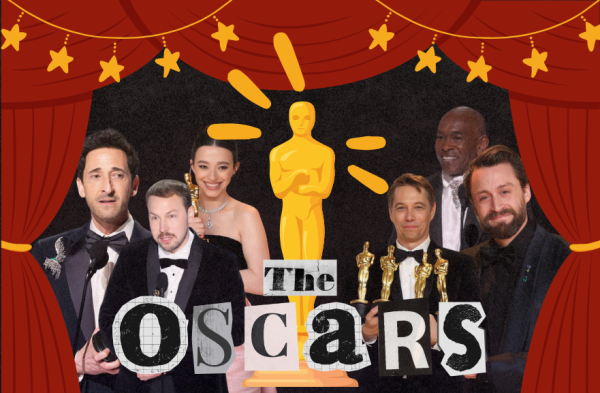Black Lives Still Matter
Black Lives Matter protesters in Huntington Beach standing up to police. Photography by: Amber Juarez.
“They’ve got their gas masks on, they’re going to tear gas y’all!” a Huntington Beach local shouts, pointing to the police officers who are threatening peaceful Black Lives Matter protesters.
Among the crowd, a teenage boy can be seen holding a gallon of milk to wash out his eyes in the event that tear gas is deployed by officers. Nearby, a white, 24-year-old male, backed by a group of white women sporting pink Women for Trump hats, screams in the faces of three Mexican-American teenagers, insisting that they, “go back to L.A.” A middle-aged man at the corner of 5th street and Orange Avenue gestures to a Starbucks boarded up with wood and hollers, “look at what they did to the building!” In the midst of arguments between protesters and Trump supporters, a voice on a megaphone chants, “Black people live here. They are your neighbors. They go to your church. They are your family.”
This was the scene at a Black Lives Matter (BLM) protest held in Huntington Beach on May 31st, six days after George Floyd died in police custody after supposedly using a fake $20 bill, which was later found to be legitimate. Police stationed at the protest actively targeted peaceful BLM protesters. While they were preparing to tear gas protesters, they did nothing to stop the aggression by white supremacists, even though they were on the verge of starting physical fights multiple times.
The BLM Movement was established in 2013 following the death of Trayvon Martin. Martin, a 17-year-old, was walking home from a convenience store wearing a hoodie. Neighborhood watch patroller George Zimmerman had called the Sanford non-emergency police line to report suspicious behavior exhibited by Martin; however, he was told not to pursue the teenager. Despite these instructions, Martin was fatally shot by Zimmerman. Although Zimmerman claimed to be acting in self-defense after a supposed physical altercation, there is little evidence to support this. After all, Martin was simply walking home, a bag of skittles and an iced tea in hand. The jury ultimately found Zimmerman, charged with second-degree murder, not guilty.
Martin’s murder gained national attention and invigorated a wave of rallies to bring attention to the racial profiling and injustice toward the Black community. Many protesters believe that Martin would not have died if he were not Black. Their idea rings true to this day. Law enforcement officers are responsible for the deaths of countless, innocent Black individuals, including but not limited to: George Floyd, Ahmaud Arbery, Rayshard Brooks, Breonna Taylor, Elijah McClain, Philando Castille, Eric Garner, and even people as young as Tamir Rice, who was only twelve years old when he was shot and killed at a park.
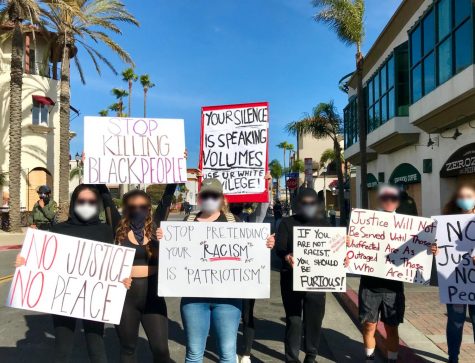
The wave of nationwide protests has been met with aggression and violence, both by law enforcement and counter-protesters, but it has also garnered the attention of legislators. Louisville lawmakers passed Breonna’s Law, named so after Breonna Taylor — whose home was raided by police on accounts of false drug-related crimes linked to her ex-boyfriend — which bans no-knock warrants. After the death of Floyd, 32 of the largest police departments in the country banned or restricted the use of chokeholds. Countless cases, such as that of Elijah McClain, an anemic 23-year-old who was murdered whilst walking home wearing a ski-mask to protect himself from the cold, have been reopened as a result of nationwide pressure to reinvestigate the cause of death of these innocent individuals.
These new policies are meant to address the racial disparities between white people and people of color (POC), and while they are a step in the right direction, they are not enough. While a handful of Black individuals may receive the justice they deserve as a result of the BLM movement, countless others are still being murdered by police. Recently, Brett Hankinson, an officer involved in the Breonna Taylor case, was charged with wanton endangerment for endangering the lives of Taylor’s neighbors by shooting the exterior walls of their apartment. He was never charged for being complicit in the actual killing. His colleague, Joshua Jaynes, was found to have falsified the no-knock warrant to enter Breonna’s household, but was never charged. Similarly, the officer determined to have fatally shot Taylor, Myles Cosgrove, never faced any legal repercussions. There must be change on a systemic level in order for true justice to be served.
As Jazmine Benson, a Black student at Huntington Beach High School and president of the Debate Club puts it, “it seems as if it’s okay to protest if you’re protesting for right-wing causes. If you protest in solidarity for Black rights, then you’re a terrorist or thug. This is the kind of bias we must address in our system. A lot of Republicans stand strongly by the Constitution until an opposing group tries to exercise those same rights. I don’t believe that violence is the answer, but if the government isn’t listening, do something that will make them listen.”
The growing BLM movement has sparked conversation among people of all different backgrounds and has prompted leaders and activists at Huntington Beach High School to take action. HBHS’ Bridges and Black Student Union collaborated to host a BLM discussion via Google Meets on June 2nd, 2020. Over 50 students tuned in to watch a presentation on police brutality and have a live discussion on the topic. Days after, these clubs, with support of HBHS teachers and Orange County Human Relations, hosted a peaceful protest in Worthy Park, sparking conversations about the BLM protests in downtown Huntington Beach. On an individual level, many non-black students at HBHS have been inspired to use their privilege to uplift the voices of the Black community.

“If all lives matter, then why don’t you care about LGBTQ rights? Why don’t you care about all the immigrants? Why don’t you care about Palestine? Why don’t you care about the Uyghurs in China? Why don’t you care about all of these different demographics, but only care about the ones who are most connected to you?” said Adam Bird, Orange County liaison for the Urban Organizer Coalition and a student at Huntington Beach High School.
As with any widespread movement, there are bound to be adversaries. Supporters of All Lives Matter (ALM) and Blue Lives Matter, two countermovements that were created to uplift oppressors and silence the opposition, are infuriated and disgusted with the BLM movement. They claim that BLM excludes other races, specifically white people, and argue that police officers are often subject to hate crimes. The tension between supporters of ALM and supporters of BLM is so intense that physical fights and verbal attacks often occur at protests, even escalating to the point where cars have plowed through crowds of people, such as in Newport Beach on June 4th, 2020. However, both of these countermovements ostracize the Black community and fail to recognize why BLM is necessary.
Although supporters of ALM emphasize the fact that more white individuals are killed by law enforcement, which is true, they fail to consider the fact that the Black community is disproportionately affected by police brutality. According to a study by Harvard researchers, Black Americans are 3.23 times more likely to be killed by law enforcement officers despite only making up 13% of the United States population. Rather than focusing on the institutional problems of the justice system, supporters of ALM and Blue Lives Matter treat the deaths of Black individuals as something that is deserved.
They point fingers. They are quick to blame Breonna Taylor’s death on the fact that her boyfriend, Kenneth Walker, shot at the police, rather than acknowledging and sympathizing with the sheer terror he must have felt while watching officers murder his innocent girlfriend. They emphasize the fact that Mr. Floyd had fentanyl in his system instead of accepting that he was unjustly and brutally murdered at the hands of police officers who suffered no consequences in the end.
Benson stated, “I have to wake up, go to school, come home, live my everyday life, and die a Black person…A police officer can take off their uniform. I can never take off my skin…I did not choose to be Black, but I was blessed with the opportunity. It is a police officer’s duty to stop crime. However, it is not their job to profile or discriminate against people like me because of the pigment of my skin. Being “blue” is an occupation; being Black is a heritage.”
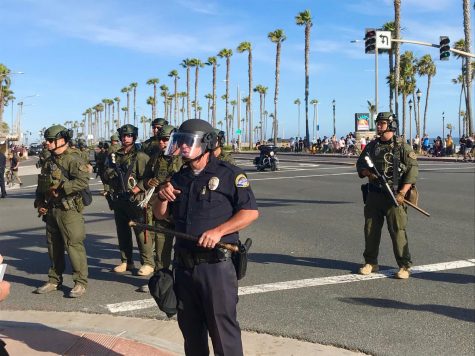
The stark contrast between the way in which law enforcement responds to supporters of BLM and supporters of ALM further emphasizes the extreme division that plagues communities across the country. This is not an issue in which there can be division. The country as a whole must come together and fight this injustice, regardless of political background. An astonishing amount of people disregard the current state of the nation because it makes them uncomfortable. According to a study by Pew Research Center, support for the BLM movement has decreased by 15% among white adults, 11% among Hispanic adults, and 6% among Asian adults since June 2020. The ability to ignore an issue that claims the lives of countless individuals is the epitome of privilege.
“Racial justice is more than just a trend, so performative activism in the form of Instagram posts and whatnot is unfortunately not enough to lessen police brutality. While the awareness spread was admirable, I’d like to see more of a sustained effort for change,” wrote Taylor Foster, a Black student at Huntington Beach High School and the Huntington Beach High School’s Green Team brand executive.
Now more than ever, we have to be proactive. This means going beyond social media: attend a protest, donate to BLM foundations, sign petitions, educate yourself and your peers. Whatever it is that you do, make sure you are actively contributing. We have already seen progress — legislation and growing support for BLM — but this fight is nowhere near over. Although BLM may fade away from social media, injustice will not dissolve until we act and bring about change. No longer can we remain silent and complicit in the face of inequality. When the voices of the Black community are stifled, we must lend them ours.
“Being racist is something deeply embedded in our country’s history…You cannot ignore the past and try to fix the future…If you can find and destroy the racism within yourself, no matter how small, you’re on your way to making progress in our community.”
-Jazmine Benson
Additional Resources:
Mental Health Resources for BIPOC
Legal Support for BLM Protesters
Justice for George Floyd – Petition
Justice for Breonna Taylor – Petition
Disbarment of Ahmaud Arbery’s Killer – Petition
Justice for Tony McDade – Petition
Justice for Tamir Rice – Petition
Your donation will support the student journalists of Huntington Beach High School. Your contribution will allow us to cover our annual website hosting costs.
Thank you for supporting our program!


